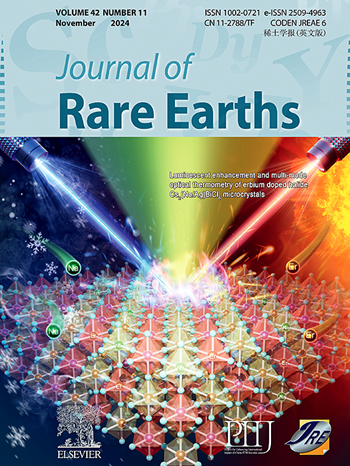LaOF对铈基磨料化学机械抛光性能的促进作用
IF 7.2
1区 化学
Q1 CHEMISTRY, APPLIED
引用次数: 0
摘要
由于其固有的化学机械抛光性能,CeO2越来越被认为是一种可行的二氧化硅基基材(如K9玻璃)抛光磨料。虽然LaOF可以改善CeO2磨料的性能,但这种增强的具体机制尚不清楚。本文采用共沉淀法制备了LaOF- ceo2复合磨料,旨在研究LaOF对磨料抛光效率的影响。研究发现,LaOF的加入使得LaOF- ceo2复合材料的初始粒径显著减小,约为41 nm,这是抛光性能提高的主要原因。此外,Ce3+含量的增加和Zeta电位的增加都是复合磨料性能优越的原因。值得注意的是,这些参数的协同效应表现在材料去除率达到1091.197 nm/min,并且当应用于K9玻璃表面时,表面粗糙度最低可达0.546 nm。这项工作的发现为LaOF在促进ce基磨料性能方面的作用提供了新的见解,可能会影响精密表面加工领域的未来发展。本文章由计算机程序翻译,如有差异,请以英文原文为准。

Promoting effect of LaOF on chemical mechanical polishing performance of cerium-based abrasives
CeO2 is increasingly recognized as a viable polishing abrasive for SiO2-based substrates, such as K9 glass, leveraging its intrinsic chemical mechanical polishing property. Although LaOF can improve the performance of CeO2 abrasive, the specific mechanism underlying this enhancement remains elusive. Herein, LaOF-CeO2 composite abrasive was prepared by co-precipitation method, aiming to elaborate on the influence of LaOF on the abrasive's polishing efficiency. It is found that the integration of LaOF results in the formation of LaOF-CeO2 composite characterized by a remarkably reduced primary particle size of approximately 41 nm, which primarily accounts for the improvement in polishing performance. Furthermore, the increasement in Ce3+ content and the Zeta potential both contribute to the superior function of the composite abrasive. Notably, the synergistic effect of these parameters is manifested in an elevated material removal rate reaching 1091.197 nm/min, coupled with a minimized surface roughness of as low as 0.546 nm when applied to K9 glass surface. The findings of this work offer novel insights into the role of LaOF in facilitating the performance of Ce-based abrasives, potentially influencing future advancements in the field of precision surface processing.
求助全文
通过发布文献求助,成功后即可免费获取论文全文。
去求助
来源期刊

Journal of Rare Earths
化学-应用化学
CiteScore
8.70
自引率
14.30%
发文量
374
审稿时长
1.7 months
期刊介绍:
The Journal of Rare Earths reports studies on the 17 rare earth elements. It is a unique English-language learned journal that publishes works on various aspects of basic theory and applied science in the field of rare earths (RE). The journal accepts original high-quality original research papers and review articles with inventive content, and complete experimental data. It represents high academic standards and new progress in the RE field. Due to the advantage of abundant RE resources of China, the research on RE develops very actively, and papers on the latest progress in this field emerge every year. It is not only an important resource in which technicians publish and obtain their latest research results on RE, but also an important way of reflecting the updated progress in RE research field.
The Journal of Rare Earths covers all research and application of RE rare earths including spectroscopy, luminescence and phosphors, rare earth catalysis, magnetism and magnetic materials, advanced rare earth materials, RE chemistry & hydrometallurgy, RE metallography & pyrometallurgy, RE new materials, RE solid state physics & solid state chemistry, rare earth applications, RE analysis & test, RE geology & ore dressing, etc.
 求助内容:
求助内容: 应助结果提醒方式:
应助结果提醒方式:


